 Last updated: August 5, 2024
Last updated: August 5, 2024
Happy July 22 – Feast Day of Mary Magdalene! Unfortunately, the timing was bad this year for hosting the MM feast day ritual at my house. I am heading off to Santa Fe soon for a long weekend with my family to celebrate my sister Lori’s fiftieth birthday. So this feast day I just thought I would offer a few comments regarding some resources related to MM that you may be interested in.
Andy and I recently returned from a trip to Spain, and the last place we visited before coming home was the Prado Museum in Madrid. It’s been 33 years since I lived there for a semester in college – when I learned to love art. My art history class was taught in the Prado and I spent a lot of time of my own there, so I was really excited to go back and see what the museum is like these days. It is still phenomenal!! You can (obviously) find Velazquez, El Greco, Murillo, Goya, but they also have a very impressive collection of Italian Renaissance painters on exhibit. Do not skip this museum when you go to Madrid! It’s definitely on par with other large and famous art museums around the world.
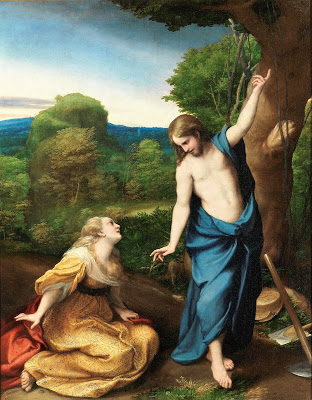 I have recently become slightly addicted to Pinterest. I have created a board of Mary Magdalene images and I am already up close to 250 images. I shouldn’t be surprised by the number and variety of interpretations, but still somehow I am. This portrait of Mary Magdalene is one of the most gorgeous paintings on exhibit in the Prado Museum. It was painted by Jusepe de Ribera in 1641 and was one of my “friends” I would see when I visited the Prado in college. And this second MM painting can also be found at the Prado. It shows the moment when Mary recognizes the resurrection of Jesus and he turns from her with the words “Noli Me Tangere,” which is often translated as “Do not Cling to Me.” This very moving and dramatic piece of artwork was painted by Antonio da Correggio in around 1535.
I have recently become slightly addicted to Pinterest. I have created a board of Mary Magdalene images and I am already up close to 250 images. I shouldn’t be surprised by the number and variety of interpretations, but still somehow I am. This portrait of Mary Magdalene is one of the most gorgeous paintings on exhibit in the Prado Museum. It was painted by Jusepe de Ribera in 1641 and was one of my “friends” I would see when I visited the Prado in college. And this second MM painting can also be found at the Prado. It shows the moment when Mary recognizes the resurrection of Jesus and he turns from her with the words “Noli Me Tangere,” which is often translated as “Do not Cling to Me.” This very moving and dramatic piece of artwork was painted by Antonio da Correggio in around 1535.
In addition to sharing these two MM images that I have always included in my feast day celebrations, I would like to share the following summaries of some of the books about MM that are in my library. Just in case you may be interested in learning more about Mary Magdalene – who truly was the Apostle to the Apostles. Most Orthodox churches use the terminology of “Equal to the Apostles,” but I think that “Apostle to the Apostles” is a better description. It fits with Jesus specifically telling her to go and bring news to the other disciples that Jesus was alive – risen from the dead! The references I list below include two books of scholarly research on Mary Magdalene and one book that presents the traditional viewpoint that Mary was a repentant prostitute and is the same person as Mary of Bethany and the un-named woman who anointed Jesus. The list also includes two books of text and commentary related to the Gospel of Mary and one book focused on developing a spirituality that is centered on MM.
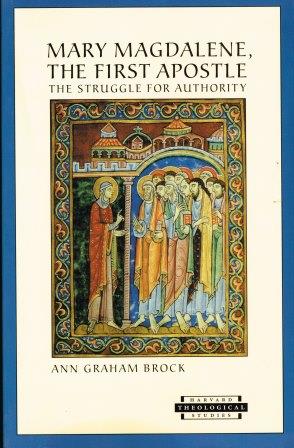 Brock, Ann Graham, “Mary Magdalene, The First Apostle: The Struggle for Authority,” Harvard University Press, Cambridge, MA, 2003.
Brock, Ann Graham, “Mary Magdalene, The First Apostle: The Struggle for Authority,” Harvard University Press, Cambridge, MA, 2003.
I loved this book and consider it to be the definitive scholarly analysis and the clearest, most complete explanation I’ve read of the Mary Magdalene tradition and how it was overshadowed by the Peter tradition and the patriarchal establishment of the Catholic hierarchy. MM was personally authorized by Jesus to be the Apostle to the Apostles, and her tradition was carried on by some of the other disciples. It’s somewhat academic and footnoted, but still not too difficult to read. It basically says that the word apostle is applied to those disciples who were witnesses to the resurrection of Christ and who were commissioned to share the good news. Mary Magdalene certainly meets the requirements of witness and commissioning, since she was the first person to witness the risen Jesus, who sent her directly to bring this great resurrection joy to the other disciples.
Schaberg, Jane, “The Resurrection of Mary Magdalene: Legends, Apocrypha, and the Christian Testament,” Continuum International Publishing Group, New York, NY, 2002.
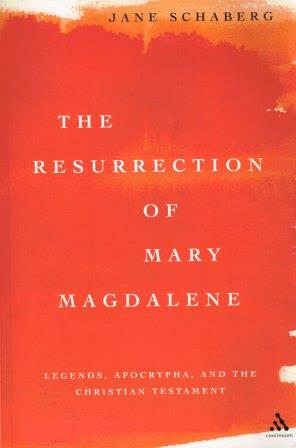 This book is also outstanding, but reader beware. It is a long and full up scholarly book with tons of footnotes, so it’s not for everyone. However, one of the parts that I loved the best was Schaberg’s description of Magdala (identified as the site of Migdal) that she has visited many times during trips to the holy land. At the time this book was written, Magdala was pretty much completely abandoned. Schaberg discusses previous archaeological excavations that failed, due to technical difficulties caused by the raised water table from the dam on the south side of the lake, and the political sensitivity associated with protecting and regulating the community’s water source that comes from underground springs.
This book is also outstanding, but reader beware. It is a long and full up scholarly book with tons of footnotes, so it’s not for everyone. However, one of the parts that I loved the best was Schaberg’s description of Magdala (identified as the site of Migdal) that she has visited many times during trips to the holy land. At the time this book was written, Magdala was pretty much completely abandoned. Schaberg discusses previous archaeological excavations that failed, due to technical difficulties caused by the raised water table from the dam on the south side of the lake, and the political sensitivity associated with protecting and regulating the community’s water source that comes from underground springs.

Davidson, Fr. Sean, “Saint Mary Magdalene: Prophetess of Eucharistic Love,” Ignatius Press, San Francisco, CA, 2017.
This book was a gift from my friend Natalie, who regularly spends time in adoration of the Blessed Sacrament. It defends the traditional idea that MM and Mary of Bethany and the woman who anointed Jesus were all the same woman. However, in support of a big tent Catholicism, Fr. Sean is careful not to harshly judge those who believe otherwise, so neither will I criticize him for his support of the traditional viewpoint. It can definitely be confusing and difficult to sort out, since many women in the gospels are referred to as “Mary,” and numerous gospel women did not have their names recorded. I did appreciate reading his commentary and support for the traditional viewpoint. It’s always good to examine issues from different perspectives. The main criticism I have of this book is that I thought it could have included more specifics about how to incorporate Mary Magdalene into the practice of adoration.
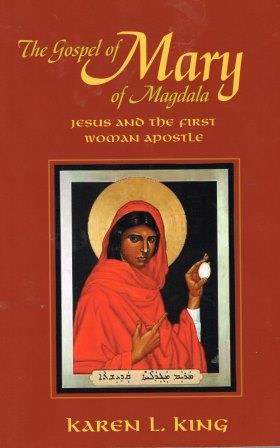 King, Karen, “The Gospel of Mary of Magdala: Jesus and the First Woman Apostle,” Polebridge Press, Santa Rosa, CA, 2003.
King, Karen, “The Gospel of Mary of Magdala: Jesus and the First Woman Apostle,” Polebridge Press, Santa Rosa, CA, 2003.
This excellent book by Karen King is about the gnostic Gospel of Mary Magdalene that was originally written in Greek during the second century. The word gnostic comes from the Greek word gnosis, which means “inner knowledge.” The discovery of fragments of several gnostic gospels, including the Gospel of Thomas, indicates that some of the early gentile Christian 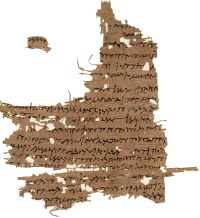 communities were on a quest to explore the inner self and to develop a more meditative and introverted spirituality. King references the 1896 discovery of a collection of fifth century papyrus fragments in the Coptic language, the main source of the Gospel of Mary text, which is often referred to as the Berlin Codex. And in the early 20th century, two papyrus fragments that were written in Greek corroborated the Berlin Codex, but did not include any additional text. I really liked that King included photos of the manuscript fragments and took the time to describe the discovery and translations of these pieces of history. Reading the gnostic gospels can give us more insight into the variety of Christianities that existed before the reign of Constantine and the standardization of the four canonical gospels. I also really loved that her translation from Greek and Coptic into English included line by line comparisons of the wording from the different manuscripts that have been found. It was very interesting to see where the lost pieces of text were located and how that complicates attempts to understand the already esoteric text. Only about half of the entire MM gospel is available (pages 1-6 and 11-14 are completely missing), largely due to the suppression of the tradition that grew up around Mary Magdalene and other gnostic writers. Gnosticism is disorienting and sounds very much different than what we are used to, but this book is very readable and is a great place to begin if you are interested in reading the gnostic Gospel of Mary Magdalene and learning more about it.
communities were on a quest to explore the inner self and to develop a more meditative and introverted spirituality. King references the 1896 discovery of a collection of fifth century papyrus fragments in the Coptic language, the main source of the Gospel of Mary text, which is often referred to as the Berlin Codex. And in the early 20th century, two papyrus fragments that were written in Greek corroborated the Berlin Codex, but did not include any additional text. I really liked that King included photos of the manuscript fragments and took the time to describe the discovery and translations of these pieces of history. Reading the gnostic gospels can give us more insight into the variety of Christianities that existed before the reign of Constantine and the standardization of the four canonical gospels. I also really loved that her translation from Greek and Coptic into English included line by line comparisons of the wording from the different manuscripts that have been found. It was very interesting to see where the lost pieces of text were located and how that complicates attempts to understand the already esoteric text. Only about half of the entire MM gospel is available (pages 1-6 and 11-14 are completely missing), largely due to the suppression of the tradition that grew up around Mary Magdalene and other gnostic writers. Gnosticism is disorienting and sounds very much different than what we are used to, but this book is very readable and is a great place to begin if you are interested in reading the gnostic Gospel of Mary Magdalene and learning more about it.
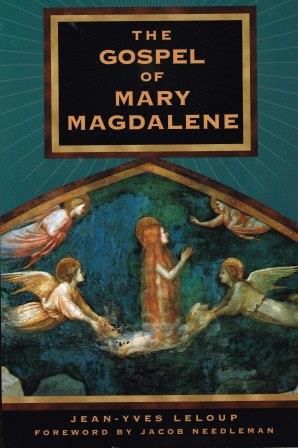 Leloup, Jean-Yves, “The Gospel of Mary Magdalene,” Inner Traditions International, Rochester, VT, 2002.
Leloup, Jean-Yves, “The Gospel of Mary Magdalene,” Inner Traditions International, Rochester, VT, 2002.
This book is also dedicated to exploring the text of the Gospel of Mary Magdalene. Similar to King’s book, translations are included opposite the Coptic text, but minus the specific reference to the fragments of the three manuscripts and their photos. Leloup’s commentary includes descriptions of parallels between the Gospel of Mary and New Testament texts, including the four canonical gospels. One such parallel can be found in the epistle of St. Paul to the Romans. Leloup includes table with a direct comparison of the Roman 7 content opposite the Gospel of Mary translation, thereby showing areas of agreement that exist, along with the text that sounds so esoteric and strange to our ears. One of the other things I like about this book is that it includes multiple translations and interpretations of the Greek words written in the text. Text translations are always key, but I think a good translation is particularly important for the gnostic gospels. Finally, Leloup goes further, describing a model that he fleshes out regarding what he believes it means to be fully human. And then of course there is the ever present gnostic mantra: “Those who have ears, let them hear.”
 Houston, Siobhan, “Invoking Mary Magdalene: Accessing the Wisdom of the Divine Feminine,” Sounds True Inc., Boulder, CO, 2006.
Houston, Siobhan, “Invoking Mary Magdalene: Accessing the Wisdom of the Divine Feminine,” Sounds True Inc., Boulder, CO, 2006.
This book is a step-by-step guide to incorporating Mary Magdalene into your spiritual practice, but can be a bit edgy, even for me. Houston writes about what she calls the Magdalene Path, a “stream of spirituality in which Mary Magdalene is the principal figure.” The book discusses some of the gnostic discoveries and traditions, but elevates MM a little more than is absolutely comfortable for me, reaching a little past the regular Catholic boundaries of asking saints to intervene with God for us. It includes resources, such as guidance for a 9-day MM novena of prayers in chapter 3 and a ritual by Soror Lucia in chapter 5 that can be used to celebrate the love and faithfulness of Mary Magdalene. This book is distributed with an accompanying CD you can use for prayer and meditation. It includes three guided visualizations, a recitation of the Holy Gnostic Rosary, and a prayer for surrounding protection from archangels Michael, Gabriel, Uriel, and Raphael. The guided meditations are very descriptive and I found the reader’s voice to be extremely calming. I especially liked the rosary recitation, but it sounds both familiar and strange, because many of the words of the Apostles Creed, the Our Father, and the Hail Mary have been altered to incorporate phrases derived from gnostic theology and symbolism. Rather than the familiar joyful mysteries, sorrowful mysteries, glorious, and luminous mysteries of the Catholic rosary, the gnostic rosary prayers proceed according to the gnostic mysteries that Houston identifies as the Assumption of Sophia, the Coronation of Sophia, the Renunciation, the Bride Chamber, and the Descent of the New Jerusalem.
The following books are also in my library and are awaiting a time when I can circle back around to having time to read them:
Bourgeault, Cynthia, “The Meaning of Mary Magdalene: Discovering the Woman at the Heart of Christianity,” Shambhala Publications, Inc., Boulder, CO, 2010.
De Boer, Esther, “Mary Magdalene: Beyond the Myth,” Trinity Press International, Harrisburg, PA, 1997.
Haskins, Susan, “Mary Magdalen: Myth and Metaphor,” Konecky & Konecky, Old Saybrook, CT, 1993.
Wishing everyone a very happy feast day of Mary Magdalene! Hopefully next year I will be back to convening the feast day celebration I sometimes call Easter in July.
UPDATE: On August 5, 2024, the links in this blog post were verified and minor editorial changes were made.
Image 1: “Penitent Magdalen,” by Jusepe de Ribera, 1641, Museo del Prado, Madrid, Spain, inventory number P001103, https://www.museodelprado.es/en.
Image 2: “Noli me tangere,” by Antonio da Correggio, circa 1525, Museo del Prado, Madrid, Spain, inventory number P000111, https://www.museodelprado.es/en.
Image 3: Mary Magdalene, The First Apostle, cover design by Eric Edstam.
Image 4: The Resurrection of Mary Magdalene, cover art and design by Stefan Killen Design.
Image 5: Saint Mary Magdalene: Prophetess of Eucharistic Love, cover art by Louis Brea, cover design by Riz Boncan Marsella.
Image 6: The Gospel of Mary of Magdala, cover image copyright Robert Lentz.
Image 7: The Gospel of Mary, text fragment in Greek, Papyrus Oxyrhynchus 3525, early third century CE, Ashmolean Library at Oxford.
Image 8: The Gospel of Mary Magdalene, cover design by Nora Wertz.
Image 9: Invoking Mary Magdalene, cover art by Dante Gabriel Rosetti.















1 Comment
Leave your reply.